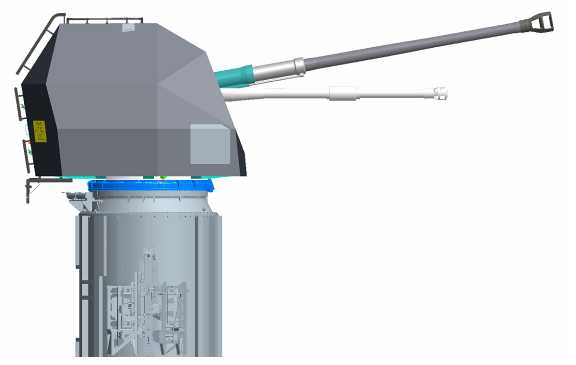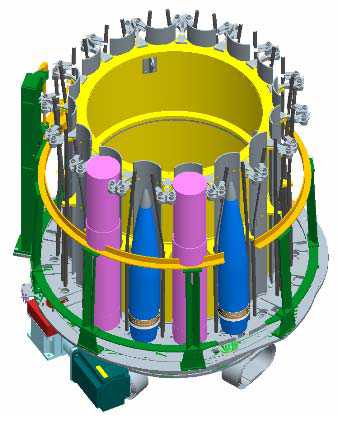During the early 2000s, the UK Ministry of Defense (MOD), DERA and RO Defence performed studies to assess future naval fire support requirements, particularly for the Type 45 destroyers then under development. Work was originally focused on developing a new 155 mm/52 "Future Naval Gun" which could take advantage of standard NATO 155 mm ammunition and the extended-range guided munitions already in development for land-based 155 mm artillery. However, MOD was unable to fund the high development cost associated with developing a 155 mm naval mounting and, in regards to the Type 45 destroyer, there were concerns that the very large magazine required would use up the volume reserved for the 16 extra VLS cells for deep strike missiles. In December 2007 it was decided that at least the first six Type 45 ships would mount the 4.5" (114 mm) Mark 8 Mod 1 gun and it seemed unlikely that the proposed follow-on units would use any other gun mounting.
In mid-2004, competition for arming the Type 45 came from United Defense, who proposed their 5"/62 (127 mm) Mark 45 Mod 4 for these ships. As part of this proposal, United Defense would sub-contract much of the assembly work to British firms, similar to what they have done for other nations. This United Defense proposal was rejected by the Royal Navy in early 2005 as being too expensive.
In response to the United Defense proposal, in December 2004 BAE Systems made a proposal to use the existing gun house for the 4.5" (114 mm) Mark 8 Mod 1, but use the same 155 mm/39 gun barrel being used on the Army's AS90 Braveheart self-propelled howitzer. BAE called this proposal the 155 mm TMF (Third generation Maritime Fire support). BAE claimed that this arrangement would not create recoil forces beyond the capability of the Mod 1 mounting and estimated that this design would weigh 24.5 tons compared with 22.5 tons for the 4.5" (114 mm) Mark 8 Mod 1 and 26.4 tons for the original Mod 0. BAE forcasted that the largest modification would be changing to a double-stroke loading cycle needed to handle modular charges. BAE estimated that this change would reduce the rate of fire to about 12 rounds per minute. There would also need to be a modification of the gun shield to allow for higher elevation angles. A short time later, the acquistion of United Defense by BAE Systems in June 2005 made any competition between BAE and United Defense moot.
BAE stated in their proposal that the Mark 8 Mod 1 gunhouse could also be used for a Fourth generation Maritime Fire support weapon (FMF) using the longer-barrel 155 mm/52, but this combination would require strengthening of the gunhouse in order to meet the added recoil forces.
MOD awarded BAE a research contract in 2007 to pursue their TMF design. However, the project was cancelled in late 2010 as part of large UK budget cuts in defense and other areas.
| Designation | 155 mm (6.1") Future Naval Gun |
|---|---|
| Ship Class Used On | Planned for Type 45 destroyers |
| Date Of Design | 2002 through 2009 for various proposals |
| Date In Service | Project Cancelled in 2010 |
| Gun Weight | BAE TMF: 5,765 lbs (2,615 kg)
52 caliber guns: N/A |
| Gun Length oa | BAE TMF: 279.2 in (7.092 m)
52 caliber guns: N/A |
| Bore Length | BAE TMF: 238.0 in (6.045 m)
52 caliber guns: N/A |
| Rifling Length | N/A |
| Grooves | BAE TMF: 48
52 caliber guns: N/A |
| Lands | N/A |
| Twist | BAE TMF: Uniform RH 1 in 20
52 caliber guns: N/A |
| Chamber Volume | BAE TMF: 1,150 in3 (18.84 dm3)
52 caliber guns: N/A |
| Rate Of Fire
(see Note) |
Requirement: about 20 rounds per minute
BAE TMF Proposal: about 12 rounds per minute |
| Type
(see Note 1) |
Modular |
|---|---|
| Projectile Types and Weights
(see Note 2) |
HE - 98 lbs. (44.5 kg) |
| Bursting Charge | N/A |
| Projectile Length | N/A |
| Propellant Charge | N/A |
| Muzzle Velocity | L15A1 projectile and eight modular charges
BAE TMF: 2,713 fps (827 mps)
|
| Working Pressure | L15A1 projectile with eight modular charges
BAE TMF: 18.5 tons/in² (2,860 kg/cm²)
|
| Approximate Barrel Life | N/A |
| Ammunition stowage per gun | N/A
8 complete rounds in ready service ring |
- As noted above, a key requirement for this program was that it be able to use standard 155 mm modular charges. This would allow a common munition program for both land and naval systems using this size caliber and thus reduce both development and service costs.
- Standard NATO of 155 mm ammunition includes high-explosive projectiles, bomblets, smoke and illuminating rounds. Future developments include smart and cargo rounds, such as those already in service in the US Army.
| Elevation | Range |
|---|---|
| 45 degrees | about 40,000 yards (36,500 m) |
| Elevation | Range |
|---|---|
| N/A | about 76,000 yards (70,000 m) |
| Elevation | Range |
|---|---|
| 45 degrees | 26,250 yards (24,000 m) |
| Designation | N/A |
|---|---|
| Weight | Future Naval 155 mm/52 Gun Mount
about 44,100 lbs. (20,000 kg) Hoist System: about 7,710 lbs. (3,500 kg) BAE 155 mm/39 TMF
BAE 155 mm/52 FMF
|
| Elevation | -15 / +80 degrees |
| Elevation Rate | N/A |
| Train | N/A |
| Train Rate | N/A |
| Gun recoil | N/A |
- All designs were required that they be able to replace the existing 4.5" (11.4 cm) Mark 8 Mod 1 mountings used on Type 45 destroyers without needing major modifications.
- Gun crew for any of these weapons is estimated at 1 gun captain, 1 gun bay attendant and 3 or 4 magazine handlers.


BAE Systems Press Releases
"The Naval Institute Guide to World Naval Weapon Systems: 1994 Update" by Norman Friedman
"Defense & Armament Heracles International" Issue #87, September 1989
---
"155mm Third Generation Maritime Fire Support (TMF)" by Robert McClure of BAE, presented at the NDIA 44th Annual Gun & Ammunition Symposium & Exhibition
---
Naval Forum UK
"Bigger is Better" post of 14 December 2007 by Douglas Barrie at Aviation Week website
---
Special help from Matthew Rodchenko
14 August 2008 - Benchmark
31 May 2010 - Added link to 155mm Third Generation Maritime Fire Support (TMF)
21 January 2011 - Project cancellation
06 September 2016 - Converted to HTML 5 format

